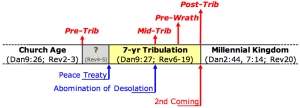The second chapter of Paul’s second epistle to the Thessalonians is a mighty tour-de-force polemic for the pre-tribulational nature of the rapture of the Church. It has long been recognized that the Restrainer of 2 Thessalonians 2:7 is the Holy Spirit, and that His removal before the Antichrist is revealed (i.e., before the Tribulation begins) necessitates the rapture of the Church due to the Spirit’s indwelling of the Body of Christ as a temple in the present dispensation (1Cor6:19). It has more recently been recognized that the “falling away” in 2 Thessalonians 2:3 (KJV; Greek, apostasia) that also must occur before the Antichrist is revealed is in context better understood to be a departure (i.e., the rapture of the Church). However, even without these clear and powerful witnesses, a pre-tribulational rapture of the Church is a necessary inference from Paul’s opening to the chapter in 2 Thessalonians 2:1-2.
FIGURE 1. Timing of the Rapture in the Pre-Trib, Mid-Trib,
Pre-Wrath, and Post-Trib Views.
In 2 Thessalonians 2:1, Paul introduces the subject of the chapter as “the coming of our Lord Jesus Christ, and our gathering together unto him”. The subject is a single event, since the first substantive clause is articulated and the second is not, being connected by an epexegetical kai in the Greek text (i.e., the Granville Sharp rule). Paul’s subject is that particular “coming of our Lord Jesus Christ” which involves “our gathering together unto him” (cf. Jn14:1-3; 1Thess4:13-18). Thus, the subject of the chapter is the rapture of the Church.
In 2 Thessalonians 2:2, it is revealed that the Thessalonians had become “shaken in mind” and “troubled”, apparently as a result of a “letter as from us” (i.e., a letter alleging to be from the Apostle Paul, which was in fact a forgery). Their alarm was caused by the fact that the letter asserted that “the day of the Lord” had begun. The remainder of the chapter presents an iron-clad polemic for why that could not possibly be the case. However, one must ask why this news so disturbed the Thessalonians; why were the Thessalonians shaken?
In 2 Thessalonians 2:5 Paul reminds the Thessalonians that he had previously instructed them concerning this subject. Indeed, Paul’s first epistle to the Thessalonians discusses the rapture in every chapter (cf. 1Thess1:9-10; 2:19; 3:13; 4:13-17; 5:1-11). Presumably Paul had taught them when the rapture would occur relative to the coming 7-year Tribulation (i.e., the day of the Lord; 2Thess2:2). If he had taught them that the rapture of the Church would occur mid-trib, pre-wrath, or post-trib (i.e., any view that sees the rapture of the Church as occurring at some point during the Tribulation; see FIGURE 1), there is no reason for the Thessalonians to be “shaken” or “troubled”. There would be no inconsistency between those rapture views and the counterfeit message alleging that the Tribulation had begun. Rather than causing them to be “shaken”, such news would be cause for excitement and anticipation, since it would mean that their rapture was necessarily drawing near. However, if Paul had taught the Thessalonians that the rapture of the Church would occur before the Tribulation begins (i.e., pre-trib), then it is easily understandable why news that it had begun would be so troubling; if true, it would mean either: 1) that Apostle Paul’s previous teaching was untrue, or 2) the rapture of the Church had already occurred, and they had been left behind.
Only a belief in a pre-trib rapture as taught to the Thessalonians by the Apostle Paul explains why they were so “shaken” and “troubled” by the counterfeit message that the day of the Lord (i.e., the Tribulation) had begun. No other rapture view would have troubled the believers at Thessalonica. Properly understood, 2 Thessalonians 2:1-2 is a powerful witness to the fact that the Apostle Paul taught that the rapture of the Church would be pre-trib!


